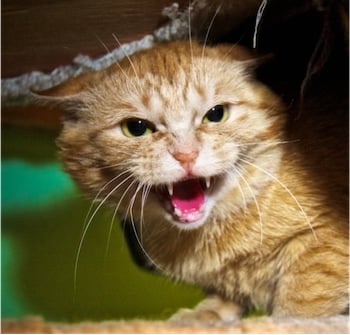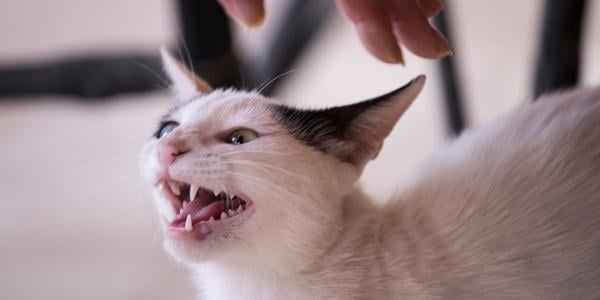 Signs of feline aggression, at least ones that we humans are able to decipher, are expressed through a cat’s body language, which includes body postures, facial expressions, and vocalization.
Signs of feline aggression, at least ones that we humans are able to decipher, are expressed through a cat’s body language, which includes body postures, facial expressions, and vocalization.
Cat vocalization is the easiest for us to interpret. Most of us recognize a growl, snarl, or hiss as a warning sign to stay away.
A cat's physical movements and postures are more complex because it involves translating the meaning of multiple body parts moving at the same time.
To complicate matters, cats use almost every part of their body to display their emotion — from the position of their ears, the direction of their body, and the movement of their paws to various body postures.
Unraveling this maze of body postures, facial expressions, and vocalization requires a bit of a roadmap. This is especially true when there is a risk of physical injury. We will guide you through the signs of feline aggression directed toward humans and, hopefully, prevent you from being the recipient of wounds inflicted by your beloved cat.
With deep gratitude, we thank Maddie’s Fund for allowing us to use material from their course, Feline Communication: How to Speak Cat, for the content of this article.
Table of Contents
Communication Is a Spectrum
Before we delve into the details of differentiating the signs of cat aggression and their meaning, it is important to remember that communication is a spectrum. That is, no one type of communication takes place in isolation, and it can change at any moment. It is a process, not an event.
What does this mean when we try to understand what a cat is saying to us? Body postures may also be accompanied by the movement of body parts. Both of these types of communication might be accompanied by vocalization. In addition, all may be accompanied by scent-laden signals, a signaling realm that is largely closed off to us humans.
Most times, the different forms of feline communication are used in concert with one another, which can cause us to miss something that the cat is trying to communicate — leading to misunderstandings and unwelcome consequences.
By studying the various ways that cats use to communicate, we develop a better understanding of the messages a cat is trying to convey. This aids in providing better care and deepening the bond of friendship with our feline companions.
Cat Body Postures that Can Indicate Aggression
As with facial expressions, a continuum, or range of body postures, reflects varying gradations in the motivational state. This continuum depicts many of the body parts and positions used by cats, putting them together to demonstrate common messages a cat might give.
Remember that body language is fluid and changes quickly. You will find that a cat might move along a line of this continuum to communicate their message in a given situation. As you can see from the labels in the margins of the Feline Body Posture Continuum below, this describes cats from a confident and relaxed state to a highly aroused, fearful, and aggressive cat.
Note the positions of the back, ears, whiskers, head, tail, body, and the level of piloerection in each state along this continuum.
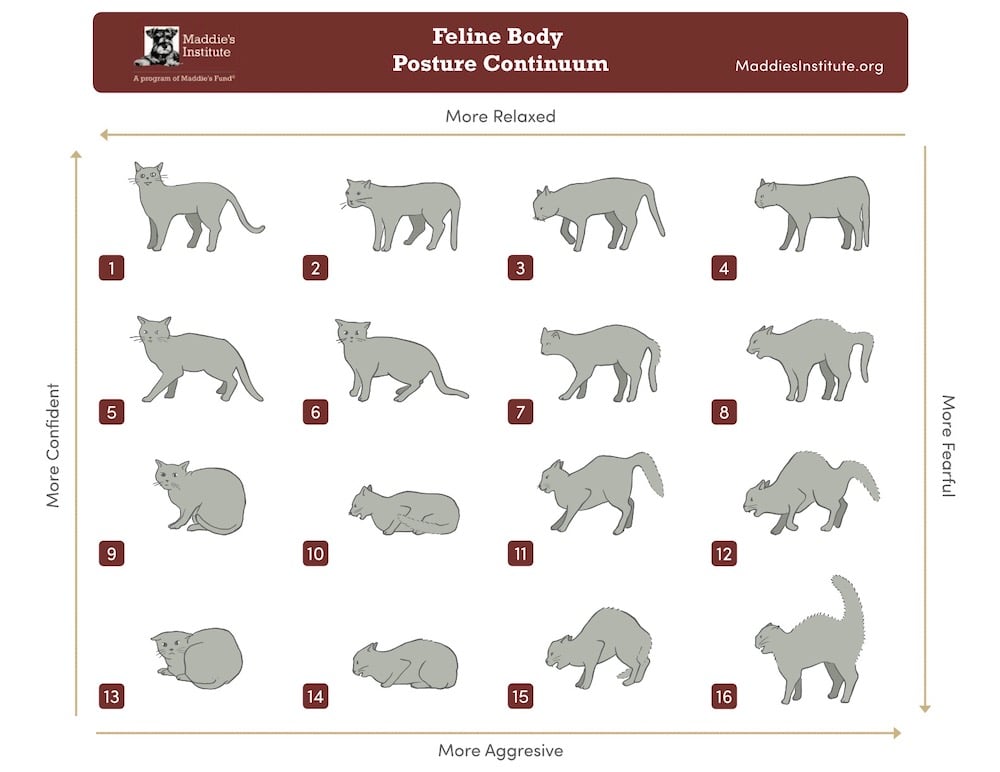
Back Arched and Fur Erect ('Halloween Cat')
This is associated with a defensive threat. As this stance progresses, the cat takes on a typical "Halloween cat" appearance. The cat leans back, presenting the side of their body to the perceived aggressor rather than a straightforward view. In addition, the ears are usually flattened, the corners of the mouth are pulled back to bare teeth, the whiskers are drawn against the side of their head, and their nose is wrinkled. All of these gestures make the cat appear larger and more threatening and are meant to cause the potential enemy to look elsewhere for a less daunting victim.

Body Position Backward
When cats have all their weight backward, they are on the defensive. If an escape route is available, they are more likely to retreat through it rather than attack because they are afraid.
With this body position, the cat usually hunkers down while backing up and leaning away from the threat. Sometimes they will deflect their head to one side, giving the appearance of a sideways glance. If pushed, it is likely that the cat will let out a hiss or a growl.
Moving Away – Distance Increasing
Distance-increasing body movements are usually silent patterns of behavior, like walking, shifting, or looking away from an unwelcomed stimulus while scoping out an escape route. It is an avoidance behavior that indicates the cat prefers to avert contact with the stimulus, whether it be a person, another animal, object, odor, or location.
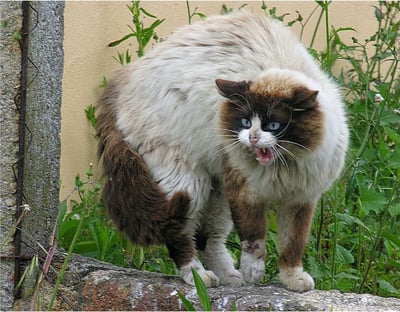
Piloerection ('Raised Hackles' or Hair Standing on End)
Piloerection, often called "raised hackles," is a nervous reflex that causes tiny muscles in the skin at the base of each hair to involuntarily contract, resulting in the hair being lifted away from the skin. It is usually triggered by cold, fright, or arousal, including aggression.
Running
Running can be in response to play or fear, be used in pursuit of prey or enemies, or just a means of getting to a different location quickly. Whether done in play, hunting, or pursuing an enemy, running takes on the form of a chase. When invoked by fear, it provides a quick getaway from the source of the fright. Check out this video to see cats running.
Swatting
Swatting is when cats use their front paws to strike or slap at an object with varying degrees of force. Since the intent is to send a message to back off and not cause physical injury, the claws are usually not exposed. Here's a video showing cat swatting:
Scratching
When done for aggressive purposes, it involves a cat whacking the perceived threat with exposed claws, intending to cause physical injury. Scratching, as well as biting, are cats' active means of defense, especially when running away to hide is not an option. Here's a video explaining cat scratching:
Tail Lowered – Base and Tip Curved
When the tail is lowered, and the base and tip are curved, forming a "hook," it is a sign of defensive aggression. The cat may also bristle the hair on the tail, arch their back, and do a bit of a crab walk. See this in action in this video:
Tail Twitching or Thrashing
The more emotionally charged the cat is, the faster the tail will thrash. A thrashing tail can mean a number of things and varies from cat to cat. Once again, it is important to consider the other communication signals exhibited by the cat to determine what they may be feeling. In general, if the tail is slightly flicking, the cat is indecisive or contemplative. If it is whipping suddenly and rapidly, they are anxious and/or agitated. If it is thrashing constantly, they are critiquing the surroundings. If it is thrashing with a thump, this signals annoyance and frustration, which could escalate to an attack.
Here's a video showing tail twitching:
Tail Vertical and Curved
If the tail extends further over the back in a U-shaped, concave position, it is associated with defensive aggression, avoidance, and distance-increasing measures.
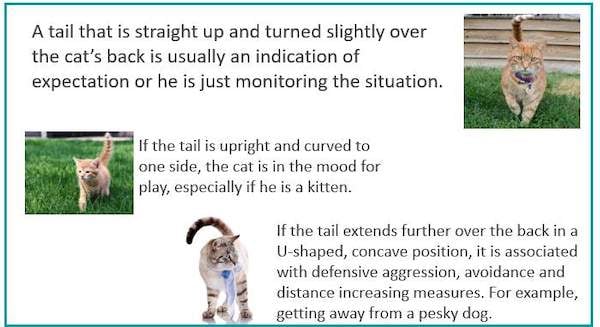
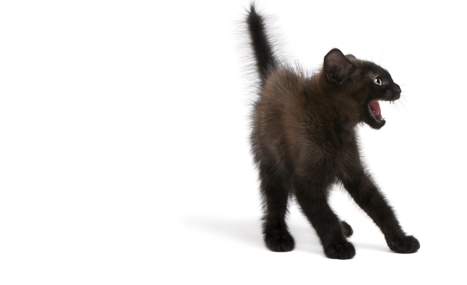
Tail Vertical, Fur Erect
A tail that is straight up with puffed-out hairs (piloerection) of the tail is an indicator of the defensive behavior of a fearful cat or the offensive behavior of a severely agitated cat. It is done as a response to make the cat look bigger in an effort to ward off any threats.
Cat Facial Expressions and Actions that Can Indicate Aggression
Facial expressions are thought to convey more subtle and rapid communications than those of the body. Consequently, they may more accurately represent rapid changes in context or motivational state. When a cat conveys a message, the face and the head give much of the information, which is typically supported by the rest of the body.
Similar to the Feline Body Posture Continuum, take a moment to study the Feline Facial Expression Continuum below to see how the ears, eyes, head carriage, mouth, and whiskers demonstrate the facial expressions of a cat from confident and relaxed to highly aroused, fearful, aggressive, and many states in between. Pay particular attention to the direction of the ears, pupil size, how far the head is from the body, and whisker placement.
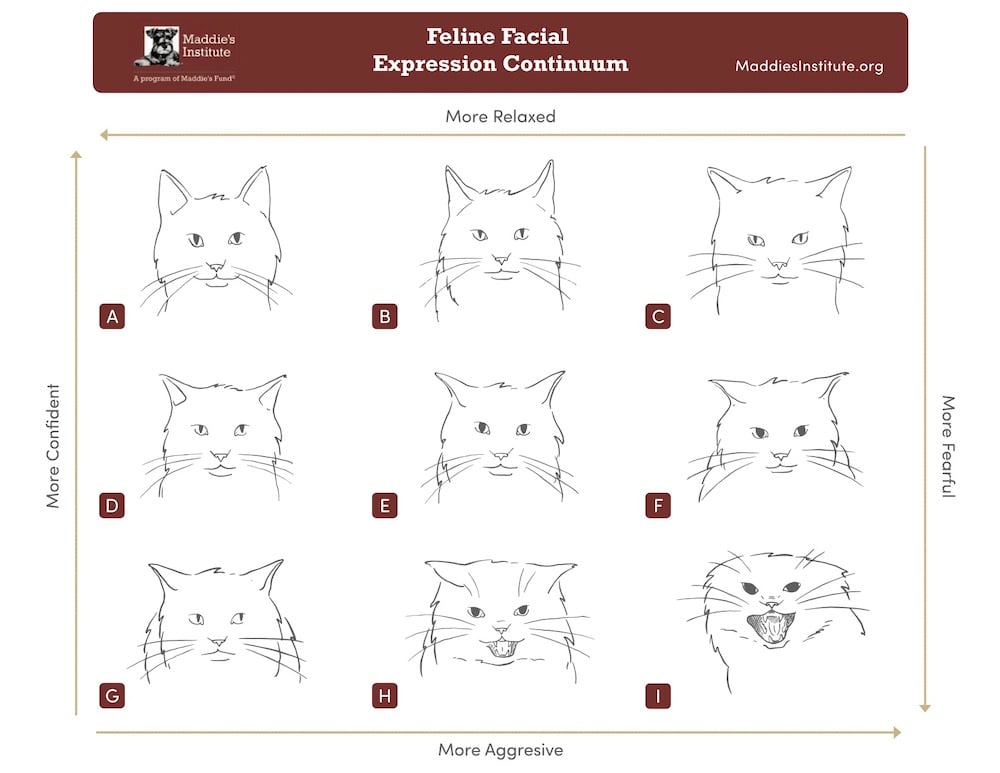
Biting
When cats bite, they clamp their teeth on or around an object. The pressure they apply with their teeth is dependent upon their intent. When biting is directed toward living beings, the motivation is either hunting, offensive or defensive aggression, an expression of irritation, or simply in play.
Although cats are not normally aggressive by nature, they will lash out and bite if they are fearful or feel threatened, so the aggression can be offensive or defensive in nature. The intent is to cause harm, so the offender backs off. Biting from irritation is an inhibited bite, typically used to end an interaction, with the message being something like, “Don’t pet me anymore.” Read more on why cats bite here.
Learn more about cat biting intentions in this video from Maddie's Fund:
Ears Flattened ('Airplane Ears')
This ear position is often referred to as "airplane ears" because the ears look a bit like airplane wings jutting from each side of the cat's head. This happens as a cat feels threatened or uneasy, signaling fear or defensiveness. The cat does this as a way of protecting the ears — keeping them out of range of things like claws and teeth — in preparation for what might come next. Consider "airplane ears" to be early warnings to back off and stop whatever has prompted the cat to feel threatened.
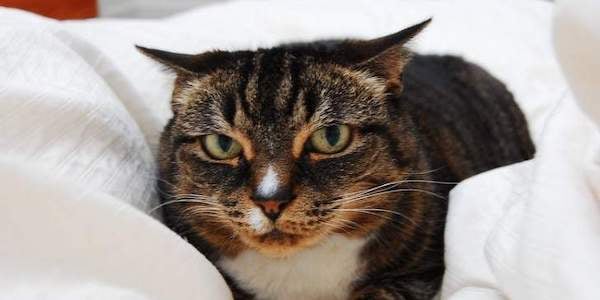
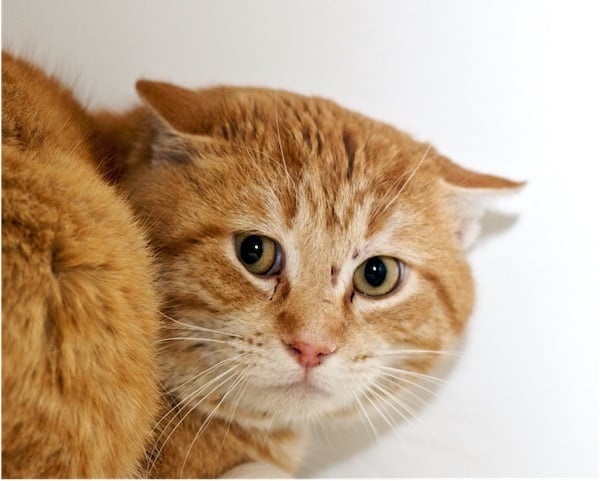
Ears Raised or Backward
When a cat moves their ears from a front-facing forward position to a backward one, it is an offensively aggressive gesture. Ears pricked up and turned backward indicate a warning that an attack is being contemplated. The less backward positioning of the ears, along with other expressions like a set neck and shoulders, slightly lowered head, and clamping of the mouth, indicate a more confident and offensively aggressive cat.
Consider the backward positioning of the ears to be early ear warnings to back off and stop whatever has prompted the cat to respond in this way.
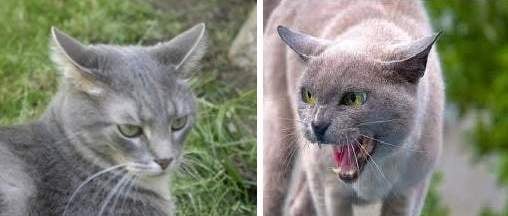
Ears Twitching
Twitching ears indicate rising agitation or the presence of an irritant. If the cause of the ear twitching is arousal, and the source of it does not go away, the cat may progress to a threat or attack. If it's happening due to an irritant that cannot be identified and/or removed, then the cat should be examined by a veterinarian to rule out pain or discomfort from medical issues. This video explores examples of cat ear twitching:
Head Lowered
A lowered head carriage can mean different things. Cats who feel fearful typically will lower their head as a sign of withdrawal and an attempt to avoid interaction. It can also be used by a cat on the offensive. This is usually coupled with slowly walking directly toward the subject of their angst with their eyes fixed on the target.
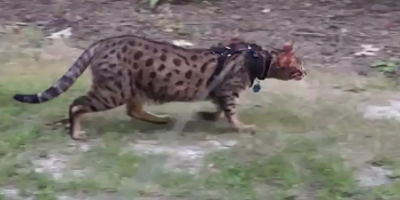
Head Stretched Forward
A head stretched forward is ready for contact. Other gestures will indicate whether the encounter is intended to be aggressive, like straight legs and elevated hindquarters, or friendly, like a straight back and relaxed rear legs.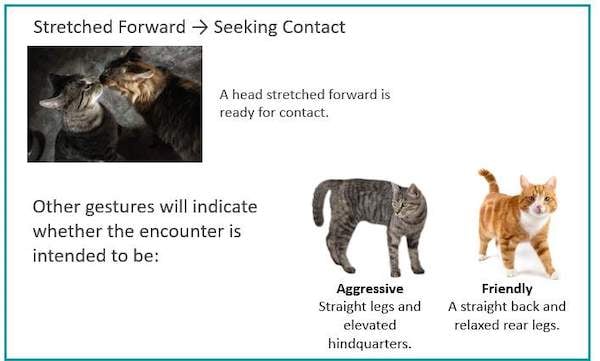
Mouth Open – Teeth Exposed
When a cat’s mouth is open with teeth bared, the lips pull back, causing the nose to wrinkle. This is commonly accompanied by hissing and is an indication of intimidation and defensive aggression.
Pupils Constricted (Small)
In bright light, pupils contract to slits (constrict). However, they also constrict in response to irritation, as well as feelings of tension and aggression.
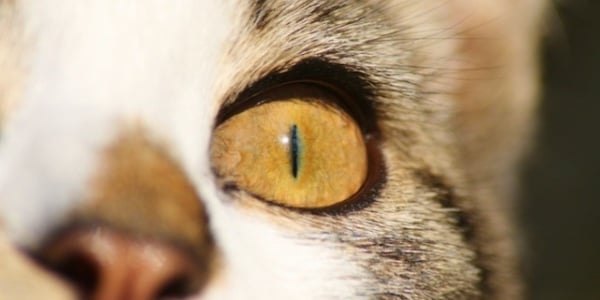
Staring
A direct stare by a cat is communicating a challenge or threat. Although people can use direct eye contact to show affection, most cats find it threatening.
Staring is used between cats as a way of establishing the pecking order. It is more likely to be seen in high-ranking, confident cats. Lower-ranking cats usually will look away and withdraw in response — humans should imitate this response as well.
Check out these examples of staring body language in this video:
Whiskers Pulled Back
When cats pull their whiskers back against the cheeks and bunch them together, it is usually an indication of fear. When in a fight or just eating, this is a way of getting the whiskers out of the way and protecting them.
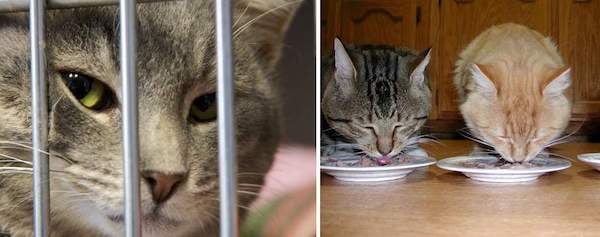
Cat Vocalizations that Indicate Aggression
Growling
A throaty sound, typically low in tone but of high intensity. It is often the first vocal warning sign that things could escalate to more aggression. In this video, listen to an example of a cat growl:
Hissing
Intended to tell the enemy to retreat and a warning sound used before claws are drawn out. The hiss is the next stage of warning after the growl in response to irritation, fear or becoming aggressive. Listen to this example of a cat hiss:
Howling
Howling sounds like loud, drawn-out meows. Low in pitch, it is often in response to stressors in the environment but can be an indication of a health problem.
Snarling
A much-heightened version of the growl, the snarl is coupled with a louder sound with a higher pitch, and often a display of the teeth. Snarling is on the continuum of escalating aggression and is usually proceeded by the first vocal warning sign, growling. It means the claws have been drawn out — or will be shortly. Watch these two cats and listen for the snarling:
Spitting
Spitting is a short, popping sound made by curling up the tongue and forcing a burst of air out. It is a defensive sound that is usually made when the cat is surprised. Spitting often precedes or follows a hiss. The cat expels their breath so hard that, if you were close enough, you could feel a jet of air. The moisture the cat releases with this gusty breath is why this vocalization is called spitting.
Can you hear the spitting of the cat in this video in between the two hisses?
Well, you have gotten a great start on your road trip to having a better understanding of feline communication! Contrary to their reputations for being mysterious creatures, cats are very communicative. We just have to know what to watch and listen for. Understanding their language takes some practice.
If you are interested in learning more, take the Maddie’s University Feline Communication: How to Speak Cat course. It’s free and you will learn how to, well, “Speak Cat”!



